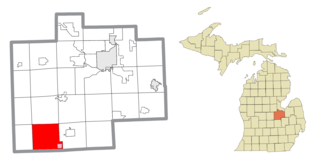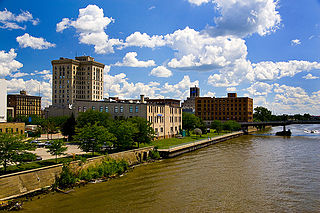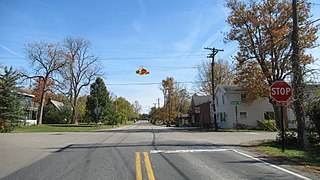

East Saginaw is a defunct city in Saginaw County in the U.S. state of Michigan. It is now part of the city of Saginaw.


East Saginaw is a defunct city in Saginaw County in the U.S. state of Michigan. It is now part of the city of Saginaw.
Much of the area that later became East Saginaw was granted by treaty to James Reilly, the Métis son of fur trader Stephen V. R. Reilly and his Chippewa wife, Men-aw-cum-ego-qua, considered the Pocahontas of the village. [1]
In 1824, the American Fur company erected a log cabin where the Bancroft house now stands and in 1826 it was tenanted by Captain Leon Snay, a celebrated French hunter and trapper. In 1849, Charles W. Grant was the first permanent American settler here and he encouraged the building of the first school-house near Snay's cabin in 1851. [2]
There were three major fires in the history of East Saginaw. The first broke out in the kitchen of the Irving house on July 5, 1854 and spread throughout the village, destroying houses, mills, stores, and 3,000,000 feet (910,000 m) of lumber. In total $101,200 worth of damages, $80,000 of which was insured for $43,000. Two days prior, the first saw mill was destroyed with a $9,000 loss on the building in addition to 500,000 feet (150,000 m) of lumber valued at $6,000. The second fire started in the Jeffers’ block on Water street on May 7, 1861 and was too large by the time it was discovered. Twenty-three buildings and property valued at $55,000 were destroyed, insured for $17,500. Despite the village burning down twice, the settlers remained, stubbornly rebuilding it once again. The third fire started in the wholesale liquor store on Washington Street on January 26, 1865 and spread rapidly to every building for an aggregated $125,000 worth of damages. [3]
East Saginaw was settled in 1850, and was incorporated as a village in 1855 and as a city in 1859. [4] On June 2, 1889, the Michigan State Legislature passed an act to consolidate the cities of East Saginaw and Saginaw City, Michigan (the west side of the Saginaw River) to form the present-day city of Saginaw, which became effective with the election of officers for the consolidated city in March 1890.

Tuscola County is a county in the Thumb region of the U.S. state of Michigan. As of the 2020 census, the population was 53,323. The county seat is Caro. The county was created by Michigan Law on April 1, 1840, from land in Sanilac County and attached to Saginaw County for administrative purposes. The Michigan Legislature passed an act on March 2, 1850, that empowered the county residents to organize governmental functions.

Saginaw County, officially the County of Saginaw, is a county located in the U.S. state of Michigan. As of the 2020 Census, the population was 190,124. The county seat is Saginaw. The county was created by September 10, 1822, and was fully organized on February 9, 1835. The etymology of the county's name is uncertain. It may be derived from Sace-nong or Sak-e-nong, as the Sauk tribe is believed by some to have once lived there. A more likely possibility is that it comes from Ojibwe words meaning "place of the outlet" –sag and ong. See List of Michigan county name etymologies.

Bay City is a city in the U.S. state of Michigan and the county seat of Bay County. The population was 32,661 at the 2020 census. It is the principal city of the Bay City metropolitican statistical area, which is conterminous with Bay County as part of the larger Saginaw, Midland, and Bay City metropolitan area.

Blumfield Township is a civil township of Saginaw County in the U.S. state of Michigan. As of the 2010 Census, the township population was 1,960.

Brady Township is a civil township of Saginaw County in the U.S. state of Michigan. As of the 2010 Census, the township population was 2,218.

Saginaw is a city in the U.S. state of Michigan and the seat of Saginaw County. The city of Saginaw and Saginaw County are both in the area known as Mid-Michigan. Saginaw is adjacent to Saginaw Charter Township and considered part of Greater Tri-Cities region of Central Michigan. The Saginaw County MSA had a population of 190,124 in 2020. The city is also the largest municipality in the Saginaw, Midland, and Bay City Metropolitan Area, with a combined population of 377,474 in the combined statistical area in 2020. The city proper had a population of 44,202 at the 2020 census.
The Thumb Fire took place on September 5, 1881, in the Thumb area of Michigan in the United States. The fire, which burned over a million acres (4,000 km2) in less than a day, was the consequence of drought, hurricane-force winds, heat, the after-effects of the Port Huron Fire of 1871, and the ecological damage wrought by the era's logging techniques. The blaze, also called the Great Thumb Fire, the Great Forest Fire of 1881 and the Huron Fire, killed 282 people in Sanilac, Lapeer, Tuscola and Huron counties. The damage estimate was $2,347,000 in 1881, equivalent to $71,170,752 when adjusted for inflation. The fire sent enough soot and ash up into the atmosphere that sunlight was partially obscured at many locations on the East Coast of the United States. In New England cities, the sky appeared yellow and projected a strange luminosity onto buildings and vegetation. Twilight appeared at 12 noon. September 6, 1881, became known as Yellow Tuesday or Yellow Day because of the ominous nature of this atmospheric event.
The Thumb is a region and a peninsula of the U.S. state of Michigan, so named because the Lower Peninsula is shaped like a mitten. The Thumb area is generally considered to be in the Central Michigan region, east of the Tri-Cities and north of Metro Detroit. The region is also branded as the Blue Water Area.

For the current city, see Saginaw, Michigan

The Dow Event Center is an indoor arena located in Saginaw, Michigan. The center consists of several parts: The Atrium, The Garden Room, The Theater, The Red Room, Huntington Event Park, and The Arena. It currently houses the Ontario Hockey League's Saginaw Spirit. The facility has housed a number of hockey teams in the past, such as the Saginaw Lumber Kings and both the IHL and UHL incarnations of the Saginaw Gears.


The history of Saginaw, Michigan explores the development of the city from the time that Native American hunter-gatherers ranged through the area. There was little settlement, though, until the 19th century when the marshes were drained to alleviate the endemic mosquito infestation.
The Flint and Pere Marquette Railroad (F&PM) is a defunct railroad which operated in the U.S. state of Michigan between 1857 and 1899. It was one of the three companies which merged to become the Pere Marquette Railway.
O-saw-wah-pon (1798-1859) was a leader of the Saginaw Band of the Ojibwe. He was a friend of Lewis Cass and in general sided with the Americans and opposed Tecumseh's plans for war. He was born in what is today the eastern part of Saginaw, Michigan and died in Isabella County, Michigan.

The Huron City Historic District is a historic district encompassing the village of Huron City, Michigan, with structures located primarily along Pioneer Drive. The district was listed on the National Register of Historic Places in 1995.
Roswell Britton was an American politician who served in the Michigan House of Representatives in its first session after adoption of the state's constitution.

The East Saginaw Historic Business District is a primarily commercial historic district located in Saginaw, Michigan and roughly bounded by Federal, North Water, North Washington and North Franklin Streets. It was listed on the National Register of Historic Places in 1982.

George Woodward Hotchkiss was an American nineteenth-century businessman and journalist who wrote about the lumber industry. He was co-founder and editor of several newspapers, including what the Journal of Forest History has considered to be North America's first lumber newspaper, Lumberman's Gazette. He contributed to the publication of a manual on the timber trade, which sold 40,000 copies. In 1898 he published the book History of the Lumber and Forest Industry of the Northwest. In the view of one 1920s author, Hotchkiss was the "father" of lumber periodicals.

George F. Lewis was a nineteenth-century American journalist and proprietor of several newspapers. He helped in the printing of the first time news of presidential election results were published. He was involved in determining there was copper ore in Michigan to be mined. He was also mayor of Saginaw, Michigan.

Mooreville is an unincorporated community in Washtenaw County in the U.S. state of Michigan. The community is located within York Township. As an unincorporated community, Mooreville has no legally defined boundaries or population statistics of its own.
43°25′08″N83°56′49″W / 43.419°N 83.947°W